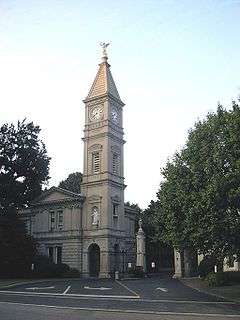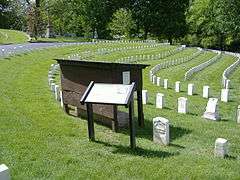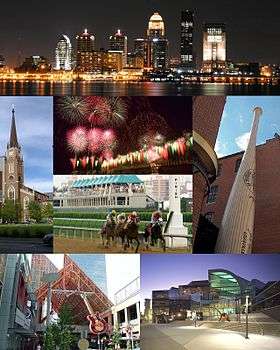Cave Hill Cemetery
|
Cave Hill Cemetery | |
|
Main entrance on Baxter Avenue | |
| Location | Louisville, Kentucky |
|---|---|
| Coordinates | 38°14′44″N 85°42′57″W / 38.24556°N 85.71583°WCoordinates: 38°14′44″N 85°42′57″W / 38.24556°N 85.71583°W |
| Area | 296 acres (1.20 km2) |
| Built | 1848–1913 |
| Architect | Various |
| Architectural style | Corinthian, Victorian, other |
| NRHP Reference # | 79000999 |
| Added to NRHP | 1979 |
Cave Hill Cemetery is a 296-acre (1.20 km2) Victorian era National Cemetery and arboretum located at 701 Baxter Avenue, Louisville, Kentucky, United States. Its main entrance is on Baxter Avenue and there is a secondary one on Grinstead Drive. It is the largest cemetery by area and number of burials in Louisville.
Cave Hill was listed on the National Register of Historic Places in 1979. Cave Hill National Cemetery, containing military graves, is also on the National Register, added in 1998.[1][2]
History
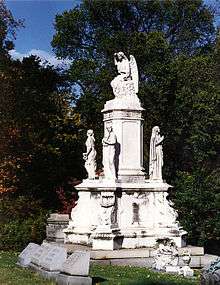
Cave Hill was chartered in 1848 on what was William Johnston's Cave Hill Farm, then a rural property some distance east of Louisville. Johnston, who died in 1798, had built the first brick house in Louisville on the grounds circa 1788. City officials had purchased part of the land in the 1830s in anticipation of building a railroad through it, and a workhouse was built there. The railroad was built elsewhere, and the land was leased to local farmers.
In 1846, Mayor Frederick A. Kaye began investigating the possibility of developing a garden-style cemetery on the grounds, a popular concept at the time. Hartford, Connecticut civil engineer Edmund Francis Lee was hired, who planned a cemetery with winding paths, graves across the tops of hills, and lakes and ponds in the valleys. The Cave Hill Cemetery Co. was chartered in February 1848, and the cemetery was dedicated on July 25, 1848. Reverend Doctor Edward Porter Humphrey delivered the dedicatory address and elaborated on the idea of the garden cemetery, noting, among other things, that ". . .Reason and taste suggest that [this cemetery] should be decorated appropriately by the beautiful productions of our great Creator. . ."
Before the era of large municipal parks, it was common for cities to promote a garden cemetery as a green oasis and recreation destination, and Louisville was no exception. This largely ended with the opening of nearby Cherokee Park in 1892.[3][4] After administrators sold several acres of land for the burial of Union soldiers during the Civil War, local Confederate supporters purchased nearby land as well. Several deceased patients from the Brown General Hospital and other nearby army medical facilities were interred in Cave Hill Cemetery.
Johnston's farmhouse (in what is now sections 33 and 34) was converted to the city's pesthouse, and was demolished in 1872. Also in 1872, Beechhurst Sanitarium was built near the pesthouse and the modern Grinstead entrance. Beechurst was torn down in 1936.
The grounds were expanded and remapped in 1888 to their modern size of nearly 300 acres (1.2 km2). In the 1980s, razor wire was added to the brick walls surrounding Cave Hill to keep out after-hours visitors.
The first scenic overlook for the cemetery, Twin Lakes Scenic Overlook, opened on August 20, 2008.[5][6]
Buildings and grounds

The signature Baxter Avenue entrance, called the Broadway Entrance by the cemetery, was completed in 1892. The Corinthian-style building includes a 2,000-pound (910 kg) bell in its clock tower. The tower, once the tallest structure for miles, was frequently hit by lightning and last renovated in 2001. The Grinstead Drive entrance was built in 1913.
The third public entrance on the residential street of Dearing Court was closed as of 2007. Another public entrance, also no longer in use, was built off Payne Street in 1910, closest to the military sections. There are several service entrances around the perimeter. Other buildings include the stone office building near the lake, and the Rustic Shelter House built in 1892 at a cost of $565.
The cemetery contains monuments and graves of three Union generals. The 32nd Indiana Monument, also known as the "August Bloedner Monument", is separately on the National Register.
The middle fork of Beargrass Creek runs through Cave Hill, and a source stream flowing into the creek roughly divides the cemetery in new (eastern) and old (western) sections. That stream flows from a spring near the cave that gave the property its name.[7] The cave can be entered for about 30 feet (9.1 m), and then there is a marginal amount of crawl space beyond that, however the cave is officially off limits. There are also five man-made lakes.
The cemetery currently features more than 500 species of trees and shrubs, including some two dozen current state champion trees, including both native species such as pignut hickory (Carya glabra) and exotics such as Caucasian wingnut (Pterocarya fraxinifolia). It is well known as an arboretum.

Interments
There were about 120,000 people interred by 2002, with space remaining for 22,000 more graves. Notable among those interred in the cemetery was American Revolutionary War military war officer George Rogers Clark (1715-1882) when Kentucky was part of Virginia.[8]
More than 200 Confederate soldiers are buried in Section "O" of the cemetery, with 30–40 buried in a row near the National Cemetery. The original wooden markers in Section "O" were replaced with stone markers in 1880–1881. A number of markers are marked as unknown. Included in the Section "O" burials is a Confederate Brigadier General, Alpheus Baker. There are two other Confederate generals buried in other locations in the cemetery. In the addition to Section "O" (lot 267½) are a number of residents of the Kentucky Confederate Home, who died around the start of the 20th century. The confederate flag flies over the area.
Within another U.S. Soldiers plot in Section E is one British war grave, of a soldier of the Machine Gun Corps, a member of the British Military Mission to the United States, who died in 1918.[9]
Muhammad Ali, boxing champion born in Louisville, was interred on June 10, 2016.
Gallery
-

Plaque with the Bivouac of the Dead
-

George Rogers Clark gravestone
-

George Rogers Clark gravesite
-

George Rogers Clark marker
-

James Guthrie monument plaque
-

James Speed interment
-

Replacement gravestone for Louisville's first mayor John Bucklin
-

Joshua Fry Speed interment, along with wife Fanny Henning Speed
-
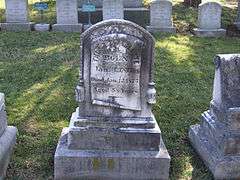
Kentucky Governor Thomas E. Bramlette's grave
Documents
See also
- Eastern Cemetery (Louisville)
- History of Louisville, Kentucky
- List of attractions and events in the Louisville metropolitan area
- List of botanical gardens and arboretums in the United States
- List of mayors of Louisville, Kentucky
- Louisville, Kentucky, in the American Civil War
- National Register of Historic Places listings in The Highlands, Louisville, Kentucky
References
- ↑ "Cave Hill National Cemetery - National Cemetery Administration". Retrieved October 21, 2016.
- ↑ "Cave Hill National Cemetery--Civil War Era National Cemeteries: A Discover Our Shared Heritage Travel Itinerary". National Park Service. Retrieved October 21, 2016.
- ↑ Goldfield, David R. (August 1975). "Living History: The Physical City as Artifact and Teaching Tool". The History Teacher. The History Teacher, Vol. 8, No. 4. 8 (4): 535. doi:10.2307/492666. JSTOR 492666.
- ↑ Hill, Sean Patrick. "Cave Hill Cemetery". Kentucky Monthly. Retrieved October 21, 2016.
- ↑ "Cave Hill Cemetery opens new scenic overlook". The Courier-Journal. August 21, 2008. Retrieved August 21, 2008.(subscription required)
- ↑ "Spirit Hunters - Cave Hill Cemetery". Archived from the original on May 3, 2009. Retrieved February 16, 2009.
- ↑ "Finding the "Cave" in Cave Hill Cemetery | The Filson Historical Society". filsonhistorical.org. Retrieved October 21, 2016.
- ↑ "Cave Hill Cemetery". Atlas Obscura. Retrieved October 21, 2016.
- ↑ "CWGC Casualty record for Hartley, J H". Retrieved October 21, 2016.
- Thomas, Samuel W., Cave Hill Cemetery: A Pictorial Guide and Its History, Cave Hill Cemetery Company, Louisville, Kentucky 1985
- "The Political Graveyard (Jefferson County, Kentucky)". Archived from the original on May 14, 2011. Retrieved May 20, 2006.
External links
- Cemetery website
- Map of the Cemetery
- Photos of selected graves with GPS coordinates
- Confederate Burials
- Confederate Burials in the Cave Hill National Cemetery
- U.S. Geological Survey Geographic Names Information System: Cave Hill National Cemetery
- Cave Hill National Cemetery at Find a Grave
- U.S. Geological Survey Geographic Names Information System: Cave Hill Cemetery
- Cave Hill Cemetery at Find a Grave
